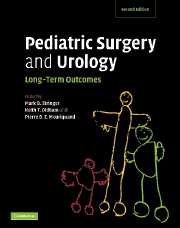Book contents
- Frontmatter
- Contents
- List of contributors
- Acknowledgments
- Preface
- Part I General issues
- 1 Introduction and historical overview
- 2 Principles of outcomes analysis
- 3 Outcomes analysis and systems of children's surgical care
- 4 Perinatal mortality and morbidity: outcome of neonatal intensive care
- 5 Psychological aspects of pediatric surgery
- Part II Head and neck
- Part III Thorax
- Part IV Abdomen
- Part V Urology
- Part VI Oncology
- Part VII Transplantation
- Part VIII Trauma
- Part IX Miscellaneous
- Index
- Plate section
- References
1 - Introduction and historical overview
from Part I - General issues
Published online by Cambridge University Press: 08 January 2010
- Frontmatter
- Contents
- List of contributors
- Acknowledgments
- Preface
- Part I General issues
- 1 Introduction and historical overview
- 2 Principles of outcomes analysis
- 3 Outcomes analysis and systems of children's surgical care
- 4 Perinatal mortality and morbidity: outcome of neonatal intensive care
- 5 Psychological aspects of pediatric surgery
- Part II Head and neck
- Part III Thorax
- Part IV Abdomen
- Part V Urology
- Part VI Oncology
- Part VII Transplantation
- Part VIII Trauma
- Part IX Miscellaneous
- Index
- Plate section
- References
Summary
William E. Ladd (1880–1967) is considered to be the father of pediatric surgery in North America. However, delving into records from the Massachusetts General Hospital (MGH), founded in 1821, discloses pediatric surgical cases cared for by surgeons 60 years before Ladd's time. A book published in 1839 by John C. Warren, who performed the first publicly demonstrated operation under general anesthesia at the MGH in 1846, included pediatric cases. A generation later, his son, J. Mason Warren, wrote a book after anesthesia was well established in which many more pediatric cases were described. When the Children's Hospital in Boston was founded in 1869 (Philadelphia Children's Hospital predated it in 1855), Benjamin Shaw, resident physician at the MGH wrote to the press, “Our existing institutions public and private provide adequately for hospital treatment of children.” He stated that 190 of 1264 (14%) admissions to the MGH in 1868 were children.
A recent book, The Children's Hospital of Boston, Built Better Than They Knew, by Clement A. Smith, describes a century of history at Children's. From 1882 to 1914 the most frequent surgical admission was for bone and joint tuberculosis. Early on there were no recognized cases of appendicitis, because Reginald Fitz at the MGH had not yet described that entity. In contrast there were 113 admissions for appendicitis from 1911 to 1913.
- Type
- Chapter
- Information
- Pediatric Surgery and UrologyLong-Term Outcomes, pp. 3 - 16Publisher: Cambridge University PressPrint publication year: 2006
References
- 1
- Cited by

